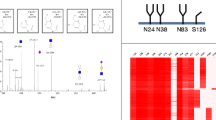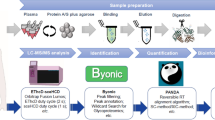Abstract
Recombinant human erythropoietin (rhEPO) is a glycoprotein that acts as the main hormone involved in regulating red blood cell production to treat anemia caused by chronic kidney disease or chemotherapy, which has three N-glycosylation sites and one O-glycosylation site. It contains a variety of different glycosylation modifications, such as sialyation, O-acetylation on sialic acids, etc., which causes a big challenge for the glycosylation analysis of rhEPO. In this study, a liquid chromatography-mass spectrometry (LC–MS) method combined with electron-activated dissociation (EAD) technology was used in qualitative and quantitative characterization of rhEPO N-glycosylation and O-glycosylation in just one injection. The usage of EAD not only generated abundant MS/MS fragment ions of glycopeptides and improved the MS/MS sequence coverage but also preserved the glycan structures in the MS/MS fragment ions and the integrity of the glycosidic bond between the glycans and peptides. Three N-glycosylation sites (N24, N38, and N83) and one O-glycosylation site (S126) of rhEPO samples were successfully identified. Among them, the glycosylation ratios of N24, N38, and N83 sites were 82.7%, 100%, and 100% respectively, and 15, 10, and 12 different N-glycans could be identified at the glycopeptide level. The total average number of sialic acids, N-hydroxyacetylneuraminoic acid, and O-acetylation on sialic acid were 7.28, 4.21, and 0.66 at the intact protein level, respectively. For O-glycosylation site S126, O-glycosylation ratios analyzed at the intact protein level and the glycopeptide level were 80.2% and 80.3%, respectively, and two O-glycans were identified, including Core1_S1 and Core1_S2. This study also compared the difference of the glycans and their relative contents in batch-to-batch rhEPO samples. The results proved that the workflow using EAD fragmentation in LC–MS method could be effectively applied for characterizing the glycosylation analysis of rhEPO samples and batch-to-batch consistency analysis, which would help to reasonably guide the optimization of rhEPO production process.






Similar content being viewed by others
Data Availability
Data are available from the corresponding authors on reasonable request.
Abbreviations
- rhEPO:
-
Recombinant human erythropoietin
- MS:
-
Mass spectrometry
- PTMs:
-
Post-translational modifications
- LC–MS/MS:
-
Liquid chromatography-tandem mass spectrometry
- LC-MS:
-
Liquid chromatography-mass spectrometry
- CE:
-
Capillary electrophoresis
- CE-MS:
-
Capillary electrophoresis-mass spectrometry
- RP:
-
Reversed phase
- CID:
-
Collision induced dissociation
- EAD:
-
Electron-activated dissociation
- KE:
-
Kinetic energy
- IAM:
-
Iodoacetamide
- DTT:
-
Dithiothreitol
- FA:
-
Formic acid
- IDA:
-
Information-dependent acquisition
- TIC:
-
Total ion chromatogram
- MS/MS:
-
Tandem mass spectrometry
References
Varki, A. (2017). Biological roles of glycans. Glycobiology, 27(1), 3–49.
Khoury, G. A., Baliban, R. C., & Floudas, C. A. (2011). Proteome-wide post-translational modification statistics: Frequency analysis and curation of the swiss-prot database. Scientific Reports, 1(1), 90.
Klein, A., & Roussel, P. (1998). O-acetylation of sialic acids. Biochimie, 80(1), 49–57.
An, H. J., & Lebrilla, C. B. (2011). Structure elucidation of native N-and O-linked glycans by [5] tandem mass spectrometry (tutorial). Mass Spectrometry reviews, 30(4), 560–578.
Rane, S. S., Ajameri, A., Mody, R., & Padmaja, P. (2012). Development and validation of RP-HPLC and RP-UPLC methods for quantification of erythropoietin formulated with human serum albumin. Journal of Pharmaceutical Analysis, 2(2), 160–165.
Harazono, A., Hashii, N., Kuribayashi, R., Nakazawa, S., & Kawasaki, N. (2013). Mass spectrometric glycoform profiling of the innovator and biosimilar erythropoietin and darbepoetin by LC/ESI-MS. Journal of Pharmaceutical & Biomedical Analysis, 83, 65–74.
Guan, Y., Zhang, M., Gaikwad, M., Voss, H., & Schlueter, H. (2021). An integrated strategy reveals complex glycosylation of erythropoietin using top-down and bottom-up mass spectrometry. Journal of Proteome Research, 20(7), 3654–3663.
Stutz, H. (2023). Advances and applications of capillary electromigration methods in the analysis of therapeutic and diagnostic recombinant proteins-A review. Journal of Pharmaceutical and Biomedical Analysis, 222, 115089.
Taichrib, A., Pioch, M., & Neusüß, C. (2012). Multivariate statistics for the differentiation of erythropoietin preparations based on intact glycoforms determined by CE-MS. Analytical and bioanalytical chemistry, 403, 797–805.
Giménez, E., Ramos-Hernan, R., Benavente, F., Barbosa, J., & Sanz-Nebot, V. (2012). Analysis of recombinant human erythropoietin glycopeptides by capillary electrophoresis electrospray-time of flight-mass spectrometry. Analytica Chimica Acta, 709, 81–90.
Chen, S., Wu, D., Robinson, C. V., & Struwe, W. B. (2021). Native mass spectrometry meets glycomics: Resolving structural detail and occupancy of glycans on intact glycoproteins. Analytical Chemistry, 93(30), 10435–10443.
Balaguer, E., Demelbauer, U., Pelzing, M., Sanz-Nebot, V., Barbosa, J., & Neusüß, C. (2006). Glycoform characterization of erythropoietin combining glycan and intact protein analysis by capillary electrophoresis-electrospray-time-of-flight mass spectrometry. Electrophoresis, 27(13), 2638–2650.
Jmeian, Y., Hammad, L. A., & Mechref, Y. (2012). Fast and efficient online release of N-glycans from glycoproteins facilitating liquid chromatography-tandem mass spectrometry glycomic profiling. Analytical Chemistry, 84(20), 8790–8796.
Yu, Y. Q., Gilar, M., Kaska, J., & Gebler, J. C. (2005). A rapid sample preparation method for mass spectrometric characterization of N-linked glycans. Rapid Communications in Mass Spectrometry: An International Journal Devoted to the Rapid Dissemination of Up-to-the-Minute Research in Mass Spectrometry, 19(16), 2331–2336.
Cao, L., Qu, Y., Zhang, Z., Wang, Z., Prytkova, I., & Wu, S. (2016). Intact glycopeptide characterization using mass spectrometry. Expert Review of Proteomics, 13(5), 513–522.
Wuhrer, M., Catalina, M. I., Deelder, A. M., & Hokke, C. H. (2007). Glycoproteomics based on tandem mass spectrometry of glycopeptides. Journal of Chromatography B, 849(1–2), 115–128.
Sinclair, A. M., & Elliott, S. (2005). Glycoengineering: The effect of glycosylation on the properties of therapeutic proteins. Journal of Pharmaceutical Sciences, 94(8), 1626–1635.
Su, D., Zhao, H., & Xia, H. (2010). Glycosylation-modified erythropoietin with improved half-life and biological activity. International Journal of Hematology, 91, 238–244.
Delorme, E., Lorenzini, T., Giffin, J., Martin, F., Jacobsen, F., Boone, T., & Elliott, S. (1992). Role of glycosylation on the secretion and biological activity of erythropoietin. Biochemistry, 31(41), 9871–9876.
Mallorquí Bagué, J. (2011). Detection of recombinant human Erythopoietin and analogues through immunorecognition and n-glycolyl-neuraminic acid identification. Journal of Biochemistry, 117, 59–62.
Giménez, E., Benavente, F., Barbosa, J., & Sanz-Nebot, V. (2008). Analysis of intact erythropoietin and novel erythropoiesis-stimulating protein by capillary electrophoresis-electrospray-ion trap mass spectrometry. Electrophoresis, 29(10), 2161–2170.
Zhang, L. L., Wang, W. T., Zhao, Y. H., Xiao, Z. L., Luo, J., Liu, B., Dong, Y. D., Li, X., & Chen, H. X. (2021). Analysis of glycopeptides in erythropoietin by CESI-MS/MS and NanoLC-MS/MS techniques. Chinese Journal of Pharmaceutical Analysis., 41(1), 79–88.
Giménez, E., Ramos-Hernan, R., Benavente, F., Barbosa, J., & Sanz-Nebot, V. (2011). Capillary electrophoresis time-of-flight mass spectrometry for a confident elucidation of a glycopeptide map of recombinant human erythropoietin. Rapid Communications in Mass Spectrometry, 25(16), 2307–2316.
Cowper, B., Li, X., Yu, L., Zhou, Y., Fan, W. H., & Rao, C. M. (2018). Comprehensive glycan analysis of twelve recombinant human erythropoietin preparations from manufacturers in China and Japan. Journal of Pharmaceutical and Biomedical Analysis, 153, 214–220.
Thomson, R. I., Gardner, R. A., Strohfeldt, K., Fernandes, D. L., Stafford, G. P., Spencer, D. I., & Osborn, H. M. (2017). Analysis of three epoetin alpha products by LC and LC-MS indicates differences in glycosylation critical quality attributes, including sialic acid content. Analytical chemistry, 89(12), 6455–6462.
Chandler, K. B., Pompach, P., Goldman, R., & Edwards, N. (2013). Exploring site-specific N-glycosylation microheterogeneity of haptoglobin using glycopeptide CID tandem mass spectra and glycan database search. Journal of proteome research, 12(8), 3652–3666.
Mechref, Y. (2012). Use of CID/ETD mass spectrometry to analyze glycopeptides. Current protocols in protein science, 68(1), 12–11.
Funding
This study was supported by Beijing Natural Science Foundation (No. L232013).
Author information
Authors and Affiliations
Contributions
YZ, YL, and HXC conceived and designed the research; XL and WTW collected and analyzed the data and wrote the manuscript; JL and LHG revised the manuscript and gave meaningful discussion and suggestions. All authors have read and agreed to the published version of the manuscript.
Corresponding authors
Ethics declarations
Ethical Approval
Not applicable.
Consent to Participate
All authors have their consent to participate.
Consent for Publication
Manuscript is approved by all authors for publication.
Competing Interests
The authors declare no competing interests.
Additional information
Publisher's Note
Springer Nature remains neutral with regard to jurisdictional claims in published maps and institutional affiliations.
Rights and permissions
Springer Nature or its licensor (e.g. a society or other partner) holds exclusive rights to this article under a publishing agreement with the author(s) or other rightsholder(s); author self-archiving of the accepted manuscript version of this article is solely governed by the terms of such publishing agreement and applicable law.
About this article
Cite this article
Li, X., Wang, W., Luo, J. et al. Comprehensive Glycosylation Characterization of Recombinant Human Erythropoietin by Electron-Activated Dissociation Mass Spectrometry. Appl Biochem Biotechnol (2024). https://doi.org/10.1007/s12010-024-04954-y
Accepted:
Published:
DOI: https://doi.org/10.1007/s12010-024-04954-y




